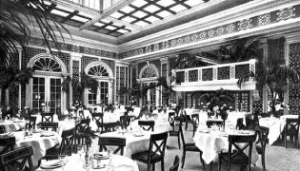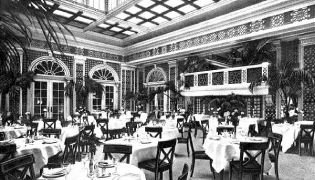Out With the Old, In with the New
The vision of the future was to construct buildings which didn’t offer arched entrances, overhanging awnings, or sandstone carved blocks. Instead, the buildings used cement dotted with pea gravel and parking terraces made of reinforced concrete. Hand-carved stone and brick was out; cinderblock, steel, skyscrapers and concrete, and very bland facades and signage were in. Did the general public adore these “buildings of the future” which would mostly be torn down just 30 years later? I suppose most agreed with the ideas. However, there was a group of advocates for “preserving the integrity and character” of downtown. Their claim in opposition to the developments was, “History should be recovered and properly displayed as part of economic and aesthetic revitalization to attract shoppers visitors and tourists.” The beautification ideas were attempting to reverse the uglification of rebuilding the city for cars.
There were many meetings, plans and ideas going back and forth between the Downtown Retailers Association and the Mayor J. Bracken Lee’s office. But it was clear it was close to impossible to get the already struggling merchants to agree to property tax hikes to improve sidewalks and beautify the streets when their businesses were struggling.

The continued preference the city gave to enticing national chains into downtown was also taking its toll on the long-time local businesses which everyone believed could never die. But the city desperately needed the tax revenue. What leaders failed to see is that by supporting national chain stores over local businesses they were, in effect, cutting off circulation to the heart. If the lifeblood of any economy is cash flow, the blood of Salt Lake City was being transfused out of the system.
For years Auerbach’s, Paris Company and ZCMI ran huge ads in the newspapers and hired local ad agencies, used local attorneys and accountants who in turn patronized local restaurants and shops. All of these businesses and supporting businesses created a vibrant, alive downtown. This was changing.
The national chain stores had little need to support local service providers. The cash flow was enriching the growing corporate empires with their headquarters usually back east, all while the economic tax base of the city was eroding. J.C. Penney and Woolworth’s were two of America’s fastest growing corporations because they understood that Madison Avenue messages were what consumers wanted to hear: low prices, great convenience, one-stop shopping.
Main Street was slowing traded for Wall Street. In the process, the very strong business owners were losing their clout with local politicians. Fred Auerbach was the leader of the Downtown Retailers Association. Auerbach’s store was by this time over 125 years old, started by his grandfather and his brother, who came to Salt Lake with the pioneers. Auerbach’s job was to save the family empire.
Did Fred Auerbach know that when the Crossroads Mall opened in 1978, Nordstroms would be enticed to locate there by Crossroads’ offering it free rent?
Likely without realizing it, this deal would both fill the city coffers full of tax revenue for a number of years, but it would also be the final nail in the coffin for the Exchange Place business owners. When Auerbach’s finally went out of business, the south end of Main Street businesses toppled like dominoes. Paris Company, Keith O’Brien, Baker’s Shoes, Broadway Music, even J.C. Penney and Cress, which were national chains, could no longer compete with the huge malls on the north end of Main Street.
The question remains: Why did City leaders agree to build the Crossroads Mall across the street from the ZCMI Center? It would have made far more sense to balance the city between north and south ends by building Crossroads on 300 South or 400 South Main? Further research is required to find this answer, but maybe Ted Wilson, who was mayor at the time, can tell us. He certainly knows the answer.
In 1983, due to the seedy area and lack of customers, the last remaining anchor which had balanced the two sides of Main Street was gone. The Hotel Newhouse on the southwest corner of 400 South and Main Street was demolished. The north end, the chain-store side, now monopolized the buying public. Was this by design? We won’t go so far to say it was, but decisions appear incredibly short-sighted in hindsight. And it really appears that foreign powers were controlling the city’s decisions more than locally elected leaders.
Little America Hotel owner and Utah billionaire, Earl Holding, acquired the former Newhouse property and the Terrace Ballroom from the Salt Lake City Redevelopment Agency. Holding received the property for a bargain because he had likely promised to the RDA that he would renovate the hotel and surrounding area. Instead, the entire historic block was demolished.

Holding’s clout with Utah politicians helped him to instead maintain a lucrative parking lot. Twenty five years later, one of the last remaining historic blocks in downtown was razed due to Holding’s strong influence with both local and national politicians. Instead of building the new Federal Courthouse on Holding’s lot, they demolished the former Port O’Call building and made Oddfellows Hall inoperable. They also demolished apartments and several more historic buildings which matched the character of the thriving Pierpont Avenue home of Market Street Oyster Bar.
So what’s the moral of this story? The moral is you cannot have a vibrant and unique downtown when it is composed of and reliant solely upon chain stores.
The trade that our city made—Main Street for Wall Street—was not unique. Denver largely made the same trade, but it has recovered better than Salt Lake City. Its downtown retail transactions do not occur mostly inside of a privately held mall space where double standards exist for locals and corporate. Malls support corporate chains in an unbalanced playing field. If there is one action all consumers can take to reverse the trends the 99 percent complain about, it’s to support locally owned and operated businesses.
There is nothing dynamic, interesting or vibrant in an economy controlled by crony capitalism where city leaders are working directly with corporate owners and developers to monopolize the buying public.
We shoppers have the power to shift our dollars back inside our own economy. We have the ability to circulate the lifeblood (our dollars) through the hands of the amazing local businesses inside of Utah. In the back of this Utah Stories we have made it very easy for shoppers to find every gift their hearts’ desire from a locally owned business.
In November, Utah Stories is launching a Kickstarter Campaign to produce a book full of historic buildings and examples showing the progression of how Main Street was Traded For Wall Street. Visit www.UtahStories.com to order your advance copy and support our efforts to return the sovereignty back to local Utah.






